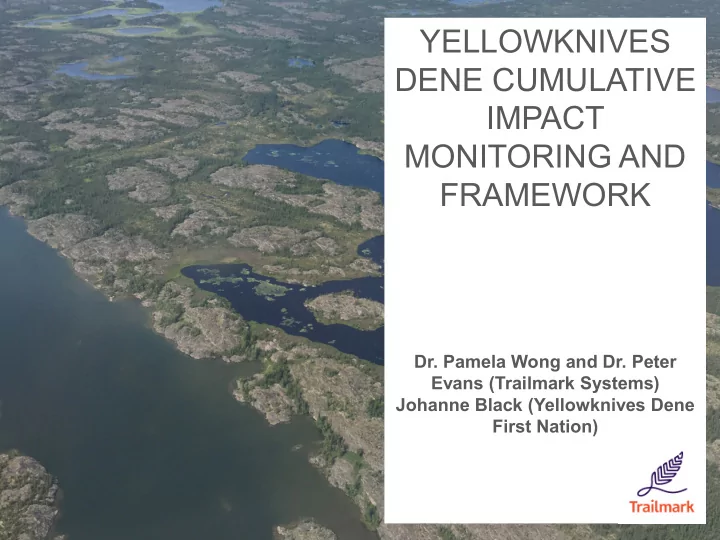

YELLOWKNIVES DENE CUMULATIVE IMPACT MONITORING AND FRAMEWORK Dr. Pamela Wong and Dr. Peter Evans (Trailmark Systems) Johanne Black (Yellowknives Dene First Nation)
OVERVIEW 1. Project Description 2. Definitions 3. Today’s Objectives
What is That? • Cumulative Effects is how scientists and governments talk about impacts to the land and people that “add up” over time and space. Objectives Methods Results Next steps
Govt. Definition Objectives Methods Results Next steps
• Scientists use a few technical terms to understand how effects accumulate or add up in the world. • Valued Components – a very important thing that you want to know about. For eg., caribou. • Indicators – what you use to measure what is going on. For example: caribou numbers. • Thresholds and Triggers – the point where you step in and do something about it. Objectives Methods Results Next steps
PROJECT OBJECTIVES ENR is developing its own cumulative effects framework. Together, we are going to make a framework for YKDFN. It will work with ENR’s, but will also accomplish what YOU need. 1. Develop a Cumulative Effects and monitoring framework Culturally-relevant model complementary to notions of “VECs”, indicators, thresholds, and triggers Objectives Methods Results Next steps
YEAR TWO OBJECTIVES 2. Conduct a harvest study to inform the framework Develop data gathering and management tools to collect information within framework Objectives Methods Results Next steps
YEAR THREE OBJECTIVES 3. Report on baseline data and recommendations Identify monitoring parameters to support framework Objectives Methods Results Next steps
Today • Talk about the phrase cumulative effects. How do you think about effects to everything – land, animals, Dene people – across time, from the past to the present. • Identify whether you have knowledge to help the GNWT with the things it wants to study (caribou, water). • Identify your OWN most important things. • Identify ways to monitor them. Objectives Methods Results Next steps
Very Important Things Objectives Methods Results Next steps
LITERATURE REVIEW
TRADITIONAL KNOWLEDGE (TK) • Empirical data collected through repeated and systematic use of the environment by communities whose survival depend on quality of this knowledge – Livelihood Objectives Methods Results Next steps
TRADITIONAL KNOWLEDGE (TK) • Rich in understanding and assessing past and present conditions, identifying “triggers” or thresholds for past and future change Objectives Methods Results Next steps
TRADITIONAL KNOWLEDGE (TK) • Retrospective and/or empirical information on natural history, ecological processes and components • How VECs respond ecologically, socially, culturally, and/or economically to stressors • Tools for investigation/monitoring/management • Local (project-specific) and regional (cumulative) effects Objectives Methods Results Next steps
LITERATURE REVIEW General challenges in cumulative effects frameworks (CEFs): • Unnecessarily complicated in service of broad VECs and/or scales • Lack of consensus on definitions for terminology • Unclear roles and responsibilities • Theory versus practice Objectives Methods Results Next steps
LITERATURE REVIEW CEFs include identifying, analyzing, and safeguarding valued ecosystem components (VECs) against CEs of multiple activities across space and time Objectives Methods Results Next steps
LITERATURE REVIEW VECs • Aspects of the environment that are important for scientific, ecological, economic, social, cultural, archaeological, historical, and/or other reasons Include natural and human aspects of the environment that are valued by local communities Objectives Methods Results Next steps
LITERATURE REVIEW • Conventional CEFs on biophysical values, favoring quantifiable indicators – Even with social and cultural values • With Indigenous communities, focus is on evaluating archaeological sites and physical landmarks by outside experts – Exclude effects on less tangible cultural aspects Objectives Methods Results Next steps
THRESHOLDS • Social thresholds = large shifts in resilience and adaptive capacity of communities, systemic cultural shifts, potential for non-compensatory losses, spiritual sites, opportunities for cultural practices Difficult to measure in practice because of lack of consensus on social scientific approach Objectives Methods Results Next steps
CONSIDERING TK
COMMUNITY ENGAGEMENT • Expert-based approaches to VECs and indicators that exclude community members may ignore most important values – Culturally-based social indicators especially important for TK – May not be quantitative – More difficult to track without communities Objectives Methods Results Next steps
COMMUNITY ENGAGEMENT • Strong collaborations among scientific, government, and Indigenous groups critical to establish justification – Best available science, TK, and Indigenous law – Ongoing challenge in CE management and approaches vary Objectives Methods Results Next steps
VALUED ECOSYSTEM COMPONENTS • Should be identified with verified knowledge-holders to ensure TK relevance • May vary among communities within regions • Indicators should have significant meaning to analysts and TK-holders/ community members Objectives Methods Results Next steps
THRESHOLDS • Maximum acceptable levels of change and/or point where management action is triggered to prevent unacceptable degradation of VECs • Should be defined according to conditions of VECs that communities consider (un)acceptable Objectives Methods Results Next steps
THRESHOLDS • No magic number • Communities should be asked how much risk they will take as trade-off for benefits Could include restrictions on any development Objectives Methods Results Next steps
THRESHOLDS • Inherently subjective – Best processional judgment – Consideration of risk – Interdisciplinary research practices and broader understanding of them are warranted Objectives Methods Results Next steps
CONSIDERATIONS • Simple frameworks that are easy to convey Easier for community members and TK holders to identify TK linkages and develop TK-based “frameworks” and processes Objectives Methods Results Next steps
CONSIDERATIONS • CEFs involving TK should be led by communities where TK is based • CEF components (e.g., VECs) and process should be co-developed in a way that is analogous to or reflects local TK terminology and concepts • CEFs involving TK will be unconventional Objectives Methods Results Next steps
CONSIDERATIONS • Adaptive approach • Consensus “guess” refined as new information on threshold becomes available • Early-warning triggers (precautionary approach) – Community-based monitoring Objectives Methods Results Next steps
NEXT STEPS
TERMINOLOGY • Identifying YKDFN conceptions of CEs • Presenting ENR’s CEF to YKDFN – Framing in a way knowledge holders can understand Objectives Methods Results Next steps
DISCUSSION
Recommend
More recommend